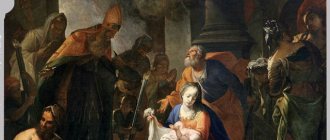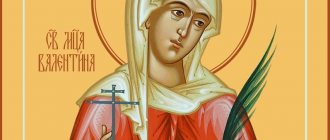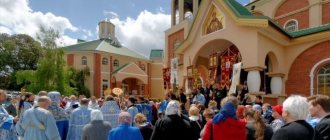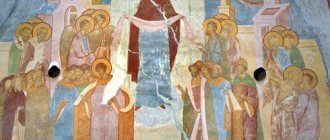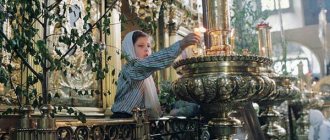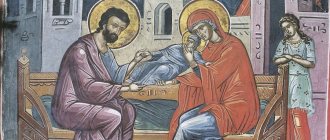Holiday Presentation (Candlemas) of the Lord, which is celebrated in Russia February, 15, in the Slavic tradition symbolizes the first meeting of winter with spring. The holiday of Presentation (in ancient Slavic this word means “meeting”) in Christianity is dedicated to an important event - the meeting of the righteous Simeon with baby Jesus.
In Orthodoxy, Presentation is one of the 12 most important holidays, in addition to Easter. It is always celebrated on February 15th.
Christian denominations living according to the modern Gregorian calendar celebrated Candlemas on February 2.
The significance of the holiday of the Presentation of the Lord, when the triumph is celebrated in Orthodoxy
On February 15, it is customary to celebrate the bright holiday of the Presentation of the Lord, the fortieth day since the birth of the Savior, which became an important turning point in Christianity. Meeting is a celebration that is considered one of the Lord's holidays, although there are similarities with the Theotokos celebrations. But we must remember that the feast of the Presentation of the Lord may fall on the first day of Lent, then the church celebration will be held the day before, on Forgiveness Sunday.
The holiday of the Presentation of the Lord is a celebration that symbolizes the important and long-awaited meeting of a sinful person with the Lord, the meeting of two covenants, the end of the old (old) and the beginning of the new - the wise Simeon, the representative of the past covenant, and the baby Savior, the representative of the future.
The celebration of the Presentation of the Lord originated in the church of Jerusalem, the counting of which dates back to the beginning of the 4th century. The Feast of the Presentation of the Lord was perceived as the final stage, after the Feast of the Epiphany. For a long time it was not a separate and independent holiday, but only the final stage in the 40-day cycle of Epiphany.
One of the first evidence of the celebration is considered to be a report on a 4th century pilgrimage to Egeria. The separation from the 40-day cycle of Epiphany took place at the dawn of the 6th century in the Church of Constantinople, and in the Roman Church it was at the end of the 5th century.
Among the Slavic peoples, the holiday of the Presentation of the Lord identified the end of frost and the arrival of spring, which became the reason for a huge number of signs.
In the Catholic religion, the Presentation of the Lord is usually celebrated on February 2 . Also, Candlemas is more often called the “day of candles” or the “purification of Mary,” one of the main traditions of which is the blessing of candles.
At the end of the Presentation of the Lord, the peasants began organizing work for “spring” affairs, preparing seeds for sowing, and driving out livestock. Also, according to beliefs, peasants could determine what the spring weather would be like - if the holiday was accompanied by rainy weather, then spring would be cold, but dry and warm weather gave confidence that warm days would continue.
Candlemas in Rus': traditions and signs
In the Slavic tradition, Candlemas is the first meeting of winter with spring against the backdrop of a waxing day and gradually receding frosts. The holiday sometimes falls on Maslenitsa , the timing of which is associated with Easter. In 2021, Orthodox Candlemas falls on Maslenitsa week for Western Christians (February 16 - Fat Tuesday, February 17 - Ash Wednesday).
Russian Maslenitsa in 2021 falls on the week from March 8 to March 14 inclusive.
According to signs, the weather at Candlemas shows what spring will be like: if it’s frosty, spring will not come soon; if there is a thaw, spring will be early and friendly.
In Rus', from Candlemas, peasants began to inspect the grain remaining from the fall, separating the seed stock. Traditionally, on this day, laying hens were fed grain to their fill so that the birds would lay eggs better. Also from Candlemas, if the weather allowed, the cattle began to be driven out of the barn into the pens.
Why does the Feast of the Presentation of the Lord fall on the 40th day after Christmas?
At the time of Christ's birth, the Jews had a tradition that dates back to the period when Moses saved the people of Israel by freeing them from slavery. According to the law of Moses, on the 40th day from the birth of a boy and on the eightieth day from the birth of a girl, parents must take the child to church, undergo a purification ceremony and make a sacrifice for the birth of a child. It consisted of the following: a lamb was burned at the stake for the birth of a baby and a dove for the purification of the mother. For poor families, it was allowed to use a dove instead of a lamb. Mary may not have undergone the rite of purification due to the immaculate conception, but her meekness helped fulfill the law of Moses. Since the family was not rich, two doves were sacrificed.
After the ceremonies, the baby and his parents were to meet Simeon and Anna. The meeting of the newborn Christ and Simeon gave rise to the great feast of the Presentation of the Lord , as the meeting of man (the wise Simeon) and God (the baby Jesus).
When can you light Sretensky candles?
Sretensky candles, popularly called “loud” candles, are lit not only during a thunderstorm. They are also used in the following extreme situations:
- if there is a fire nearby;
- when the elements are raging, and not necessarily near your home;
- during childbirth, if a woman cannot give birth for a long time;
- when one of the relatives passes into another world: a candle will ease the suffering.
“Meeting” - this is how “Meeting” is translated, what kind of meeting are we talking about
“Meeting” from the Church Slavonic language means “meeting”. An important meeting between a person and the Lord.
The holiday of the Presentation of the Lord is dedicated to the forty-day meeting of Christ with the faithful servants of the Lord. His parents, the Mother of God Mary and Joseph, came to Jerusalem to fulfill the law regarding infants. At the end of the ceremony, an acquaintance with the elder and the prophetess took place. Simeon's presence in the temple was necessary for the fulfillment of the prophecy given to him by the angel.
As you know, Simeon was one of the translators of God's letter into Greek. While working on the book of Isaiah, he read a prophecy that read, “Behold, the virgin will be with child and give birth to a Son.” Not believing in the possibility of fulfilling what was written, he decided to make a change, replacing the word “Virgo”, which meant virgin, with the more suitable word “Wife”. But the angel who appeared did not allow this to be done. In addition, he made a promise that the righteous old man would live long, and he himself would be convinced of the authenticity of the prophecy. And so, on the day of the ceremonies, a meeting took place with the three-hundred-year-old elder Simeon. The prophecy has come true.
When is Orthodox Easter this year?
Another meeting was about to take place for the great Infant, with Anna, a prophetess who lived and worked in the temple for a long time, glorifying the word of God. Seeing the Child of God, she recognized him as the Savior, bowed to him, and left to carry the good news of the coming of the Messiah. After these meetings, the family returned home, as the law said.
Notes[ | ]
- Dyachenko G. M.
Complete Church Slavonic dictionary. - 1899. - P. 655. - In particular, in Lutheranism.
- See Old Calendar churches.
- The Presentation of the Lord in the Temple // Biblical Encyclopedia of Archimandrite Nikephoros. - M., 1891-1892.
- ↑ 1 2 3 Ruban Yu. I.
Presentation of the Lord. (Experience of historical and liturgical research). St. Petersburg, 1994 - Lukashevich A. A.
Lord's holidays // Orthodox Encyclopedia. - M.: Church Scientific, 2006. - T. XII: “Gomel and Zhlobin Diocese - Grigory Pakurian.” — P. 173—178. — 752 p. — 39,000 copies. — ISBN 5-89572-017-X. - Liturgical books in Greek. February menaion, day 2. (inaccessible link)
- ↑ 12
Orthodox calendar. February, day 2. Pravoslavie.ru - The rite of blessing candles for the Presentation/
- Holidays of the Roman Catholic Church
What is the idea of the Feast of the Presentation of the Lord?
The main meaning of the holiday of the Presentation of the Lord is the saving meeting of humanity, in the form of the righteous Simeon, with the source of strength and goodness, truth and beauty, with God. This meeting is described in the Bible, Gospel of Luke, chapter 2, article 22-40 .
In this feast of the Presentation, Simeon is a representative of the Old Testament, an example of the prophets who not only understood the will of God, but also obeyed it, preaching about the coming of the Savior of mankind. This period carried faith in the One Creator, based on fear of punishment. It didn’t matter whether people understood God’s law; if they did something wrong, they would face punishment. This helped former slaves come to the right life.
With the coming of the Messiah, humanity receives a different, saving faith. It carries the idea of Love, Forgiveness and Mercy. This is precisely the border between two eras in the Christian religion. The main essence of life before the coming of the Savior was in anticipation of a joyful acquaintance with God - the Presentation of the Lord.
The anticipation of the Presentation of the Lord began at the dawn of humanity, when a disastrous event severed the connection between humanity and the Lord. When the first family, Adam and Eve, neglected the only prohibition of God and tasted the fruit of knowledge, which served to erect a huge wall of alienation between the Lord and man.
Since then, believers have been in search of salvation, hoping for the coming of the Son of God. And after a long time, the prophecy from the book of Isaiah came true and the 300-year-old elder Simeon took Christ into his own hands. The Meeting of the Lord is a great holiday, because the separation from God has ended, the Messiah has come, who will save them and return them to the Lord.
How to celebrate the Presentation of the Lord, what is possible and what is better not to do on this day
According to custom, candles are blessed on the day of the Presentation. It is customary to treat them in a special, reverent way. The first candle is lit after returning home from church, the rest are usually kept throughout the year and lit only when praying at home.
What to do during the holiday
Orthodox people honor the main traditions of the holiday of the Presentation of the Lord in this way: · By visiting the temple with communion; · Baptism of children; · Prayers at home, if you can’t go to church; · Lighting with candles, which you can then take home; · Helping people in need, caring for loved ones; · Before the feast of the Presentation, the home is put in order; · Believers exchange icons; · Baptism of water. This water has medicinal properties and helps with diseases.
What is prohibited to do during the holiday of the Presentation of the Lord
· Work. It is prohibited to perform any work other than that which is for the benefit of people. · Drinking alcohol. Alcohol has the ability to cloud the mind and make you addicted. It is believed that alcohol is a harm from the evil one. · Do the homework. It's better to devote time to the Lord. And it’s better to do cleaning and laundry on weekdays. Perhaps spend time with family and friends. · Quarrels and scandals are prohibited. · Ban on washing. You need to wash on the eve of the Presentation in order to meet the celebration clean. · Handicrafts. It distracts from going to church and praying. · Fortune telling and rituals. Belief in God is contrary to magic and rituals.
Icons dedicated to the Presentation
The icon for the feast of the Presentation of the Lord consists of five figures. In the center is the Infant Jesus, next to the Mother of God, and a little higher the righteous Simeon. Mary hands her Child to the elder, Father Joseph with a pair of doves is located on the left side, and Anna the prophetess holds a scroll.
Presentation of the Lord - gif pictures, cards and congratulations
One Roman church, Santa Maria Maggiore, contains the oldest image of this event. The image is located in the triumphal arch, in the form of one of the mosaics, which depicts the Virgin Mary with her baby going to meet Simeon. The date of its creation is the first half of the 5th century.
In Rus' there are two ancient images that are dedicated to the feast of the Presentation and dated back to the 12th century: One is located in Kiev, St. Cyril Church. In this image, the baby is sitting in the arms of the Virgin Mary. The second is located in Novgorod.
In Georgian iconography, there is no image of an altar on the icon; in its place there is a burning candle, which symbolizes sacrifice.
Also, the icons of the Feast of the Presentation of the Lord include the image “Softening Evil Hearts,” also known under another name “Simeon’s Prophecy.” He personifies the prediction of the humble Simeon, uttered during the celebration of the Presentation. The icon depicts seven swords: three on the left, three on the right and one below, piercing the heart of the Mother of God, who stands on the clouds. The swords depicted in the picture symbolize grief, sadness and pain - what she experienced during her life on earth.
